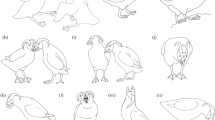Abstract
A discrimination apparatus was introduced into the cage of two mandrills (Papio sphinx) in the Washington Park Zoo. Besides testing the animals’ discrimination abilities, this apparatus provided interactions between zoo visitors and the mandrills. Although the apparatus was available to both animals, the male did not allow the female access.
This report describes space usage and changes in principal behaviors as a function of introducing the apparatus. General activity levels of both animals were increased; however, stereotypic behaviors were reduced as trials progressed. The introduction of novel stimuli and response possibilities enhanced space usage while reducing activities typically attributed to boredom.
Similar content being viewed by others
References
CHASAN, D. 1974. In this zoo, visitors learn, though no more than animals. Smithsonian, 5, 4, 22–29.
DEVORE, I., & HALL, K. R. L. 1965. Baboon ecology. In I. Devore (Ed.), Primate behavior: Field studies in monkeys and apes. New York: Holt, Rinehart & Winston.
GLICKMAN, S. E., & SROGES, R. W. 1966. Curiosity in zoo animals. Behavior, 26, 151–188.
GRZIMEK, B. 1972. Animal life encyclopedia. Vol. 10. New York: Van Nostrand Reinhold.
HILL, W. C. D. 1970. Primates: Comparative anatomy and taxonomy. Vol. 8. Edinburgh: Edinburgh University Press.
MARKOWITZ, H. 1974. Analysis and control of behavior in the zoo. In G. Robb (Ed.), Research in zoos and aquariums. Washington: National Academy of Sciences.
MARKOWITZ, H. 1975a. In defense of unnatural acts between consenting animals. Proceedings of the 51st Annual Western Aazpa Conference, Calgary. Topeka: Hill’s Division, Riviana Foods.
MARKOWITZ, H. 1975b. New methods for increasing activity in zoo animals: Some results and proposals for the future. In Centennial symposium on science and research, Penrose Institute, Philadelphia Zoological Gardens. Topeka: Hill’s Division, Riviana Foods.
MARKOWITZ, H., & WOODWORTH, G. 1978. Experimental analysis and control of group behavior. In H. Markowitz & V. Stevens (Eds.), The behavior of captive wild animals. Chicago: Nelson-Hall.
MYERS, W. 1978. Applying behavioral knowledge to the display of captive animals. In H. Markowitz & V. Stevens (Eds.), The behavior of captive wild animals. Chicago: Nelson-Hall.
NAPIER, J. R., & NAPIER, P. H. 1967. A handbook of living primates. New York: Academic Press.
ROWELL, T. 1972. Social behavior of monkeys. Baltimore: Pengu in Books
Author information
Authors and Affiliations
Rights and permissions
About this article
Cite this article
Yanofsky, R., Markowitz, H. Changes in General Behavior of Two Mandrills (Papio Sphinx) Concomitant with Behavioral Testing in the Zoo. Psychol Rec 28, 369–373 (1978). https://doi.org/10.1007/BF03394548
Published:
Issue Date:
DOI: https://doi.org/10.1007/BF03394548




